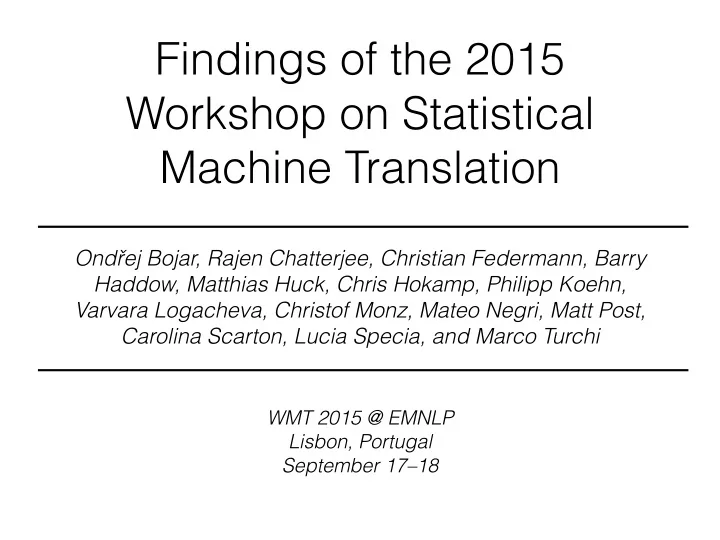

Findings of the 2015 Workshop on Statistical Machine Translation Ond ř ej Bojar, Rajen Chatterjee, Christian Federmann, Barry Haddow, Matthias Huck, Chris Hokamp, Philipp Koehn, Varvara Logacheva, Christof Monz, Mateo Negri, Matt Post, Carolina Scarton, Lucia Specia, and Marco Turchi WMT 2015 @ EMNLP Lisbon, Portugal September 17–18
Human Evaluation • We wish to identify the best systems for each task
Human Evaluation • We wish to identify the best systems for each task – Automatic metrics are useful for development, but must be grounded in human evaluation of system output
Human Evaluation • We wish to identify the best systems for each task – Automatic metrics are useful for development, but must be grounded in human evaluation of system output • How to compute it?
Human Evaluation • We wish to identify the best systems for each task – Automatic metrics are useful for development, but must be grounded in human evaluation of system output • How to compute it? – Adequacy / fluency, sentence ranking , constituent ranking, constituent OK, sentence comprehension
Metric / Year ‘06 '07 '08 '09 '10 ’11 '12 '13 '14 '15 ● ● Adequacy / fluency ● ● ● ● ● ● ● ● ● Sentence ranking ● ● Constituent ranking ● Const OK (Y/N) ● ● Sentence comprehension slide due to Ondrej Bojar
Metric / Year ‘06 '07 '08 '09 '10 ’11 '12 '13 '14 '15 ● ● Adequacy / fluency ● ● ● ● ● ● ● ● ● Sentence ranking ● ● Constituent ranking ● Const OK (Y/N) ● ● Sentence comprehension slide due to Ondrej Bojar
Sentence Ranking A > {B, D, E} B > {D, E} C > {A, B, D, E} D > {E} = 10 pairwise rankings https://github.com/cfedermann/Appraise/
More Judgments
More Judgments • Innovation: rank distinct outputs instead of systems
More Judgments • Innovation: rank distinct outputs instead of systems
More Judgments • Innovation: rank distinct outputs instead of systems • Then, distribute rankings across systems:
More Judgments • Innovation: rank distinct outputs instead of systems • Then, distribute rankings across systems:
→ System Ranking • Pairwise sentence rankings are aggregated and used to compute the system ranking Herbrich et al. (2006) Hopkins & May (2013), Sakaguchi et al. (2014)
→ System Ranking • Pairwise sentence rankings are aggregated and used to compute the system ranking • As with WMT14, we used TrueSkill Herbrich et al. (2006) – Online method, maintains a Gaussian for each system – Updates means as games are played – Updates proportional to the outcome surprisal Hopkins & May (2013), Sakaguchi et al. (2014)
Clustering • A total system ranking is somewhat bogus – Lots of similar approaches, same underlying tech – Cycles present (Lopez, WMT 2012) • Instead, compute partial orders, or clusters: – Compute rank of each system over 1,000 bootstrap- resampled folds – Throw out top and bottom 25 ranks, collect ranges – Groups systems by non-overlapping ranges Koehn (IWSLT 2013)
Participation • 68 entries from 24 institutions • +7 anonymized commercial, online, and rule-based systems • New! Finnish
Participation • 68 entries from 24 institutions • +7 anonymized commercial, online, and rule-based systems • New! Finnish
Data collected • 137 trusted annotators 2014 328 Pairs Expanded 2015 290 Pairwise judgments (thousands) • Punctuation was ignored in collapsing statmt.org/wmt15/results.html
Data collected • 137 trusted annotators 2014 328 Pairs Expanded 2015 290 542 Pairwise judgments (thousands) • Punctuation was ignored in collapsing statmt.org/wmt15/results.html
Comparison with BLEU
Results
Czech–English cluster constrained not constrained 1 online-B 2 uedin-jhu 3 uedin-syntax, montreal 4 online-A 5 cu-tecto tt-bleu-mira-d, tt-illc-uva, tt- 6 bleu-mert, tt-afrl, tt-usaar-tuna tt-dcu, tt-meteor-cmu, tt-bleu- 7 mira-sp, tt-hkust-meant, illinois
English–Czech cluster constrained not constrained 1 cu-chimera 2 uedin-jhu online-b 3 montreal 4 online-a 5 uedin-syntax 6 cu-tecto 7 commercial1 8 tt-dcu, tt-afrl, tt-bleu-mira-d 9 tt-usaar-tuna 10 tt-bleu-mert 11 tt-meteor-cmu 12 tt-bleu-mira-sp
Russian–English cluster constrained not constrained 1 online-g 2 online-b afrl-mit-pb, afrl-mit-fac, afrl-mit- 3 h, limsi-ncode, uedin-syntax, promt-rule, online-a uedin-jhu 4 usaar-gacha 5 usaar-gacha 6 online-f
English–Russian cluster constrained not constrained 1 promt-rule 2 online-g 3 online-b 4 limsi-ncode online-a 5 uedin-jhu 6 uedin-syntax 7 usaar-gacha 8 usaar-gacha 9 online-f
German–English cluster constrained not constrained 1 online-b 2 uedin-jhu, uedin-syntax, kit online-a 3 rwth, montreal 4 illinois dfki, online-c 5 online-f 6 macau online-e
English–German cluster constrained not constrained 1 uedin-syntax, montreal 2 prompt-rule, online-a 3 online-b 4 kit-limsi 5 uedin-jhu, kit, cims online-f, online-c 6 dfki, online-e 7 uds-sant 8 illinois 9 ims
French–English cluster constrained not constrained 1 limsi-cnrs, uedin-jhu online-b 2 macau online-a 3 online-f 4 online-e
English–French cluster constrained not constrained 1 limsi-cnrs 2 uedin-jhu online-a, online-b 3 cims 4 online-f 5 online-e
Finnish–English cluster constrained not constrained 1 online-b abumatran-comb, uedin- promt-smt, online-a, uu, 2 syntax, illinois uedin-jhu 3 abumatran-hfs 4 montreal 5 abumatran 6 sheff-stem limsi, sheffield
English–Finnish cluster constrained not constrained 1 online-b 2 online-a 3 uu 4 abumatran-comb 5 abumatran-comb 6 aalta, uedin-syntax abumatran 7 cmu 8 chalmers
Looking forward
Looking forward • Pilot: return to direct evaluation (Graham et al., 2015)
Looking forward • Pilot: return to direct evaluation (Graham et al., 2015) • Potential advantages: – Direct measure of the pursued quality – Conceptually simpler? – O(n) instead of O(n 2 ) – More statistically significant pairwise cmps.
Recommend
More recommend